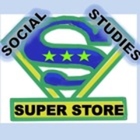But for others, this is might be the last week of school. And, sometimes this last week of school teachers are in this state of limbo with a few more days before the break. What to do with finals completed, books checked in, but many of our students have checked out....
I LOVE this time of the school year. For, this is the time I can indulge myself and my students and go a little deeper into a historical subject that we did not have time for during the year.
One way I do this is showing a historically based movie. Why? Because kids LOVE movies, and I LOVE history.
So here are a few of my favorite movies I have shown to my students at the end of the school year.
1) 42 - This is the best movie to grab my students attention. It has it all; sports, history, and a very compelling true story. 42 is about Jackie Robinson signing on with the Brooklyn Dodgers organization in 1945 to his historic 1947 rookie season and how he struggled against racism all the while breaking the color barrier in Major League Baseball.
2) The Bridge of Spies - WOW, what a great historical thriller! This takes place during the Cold War and is based on the 1960 U-2 incident during the Cold War the film tells the story of lawyer James B. Donovan, who is entrusted with negotiating the release of Francis Gary Powers. But students will also learn more about the Berlin Wall, life in the East, and details of the American U-2 spy plane incident that was shot down over the Soviet Union.
3) The Cinderella Man - A great movie for students to learn how daily life was for the average American during the Great Depression. But, this movie is centered upon an average guy who has a chance to fight back. This movie is very engaging since it's another great historical story that includes boxing and history.
4) Flags of Our Fathers - I had to include at least one war movie. But, this is not your typical American war movie. It tells a story of how history is open to interpretation. How eyewitnesses see events differently, how others view historical events and what those events mean to them. The movie is centered around the 1945 Battle of Iwo Jima, the five Marines and one Navy Corpsman who were involved in raising the flag on Iwo Jima, and the aftereffects of that event on their lives. A powerful movie for the end of they year.
5) Miracle - Okay, another sports/history movie. But, why not? These stories are engaging. This is about the 1980 American men's hockey team defeating the Soviet Union, and later winning the gold medal. All though the historical aspects are down played in the movie, the Cold War revival is there - and the other events weave their way into the story such as the American boycott of the 1980 summer Olympic games.

Then, to top it off, I have movie guides to go with all these movies. Please feel free to check them out here. Don't forget to click on the HISTORICAL MOVIE GUIDES tab in the upper left...
Also, if you are looking for the best Social Studies resources on the Internet, take a few minutes to check out the entire Social Studies SUPER store.




